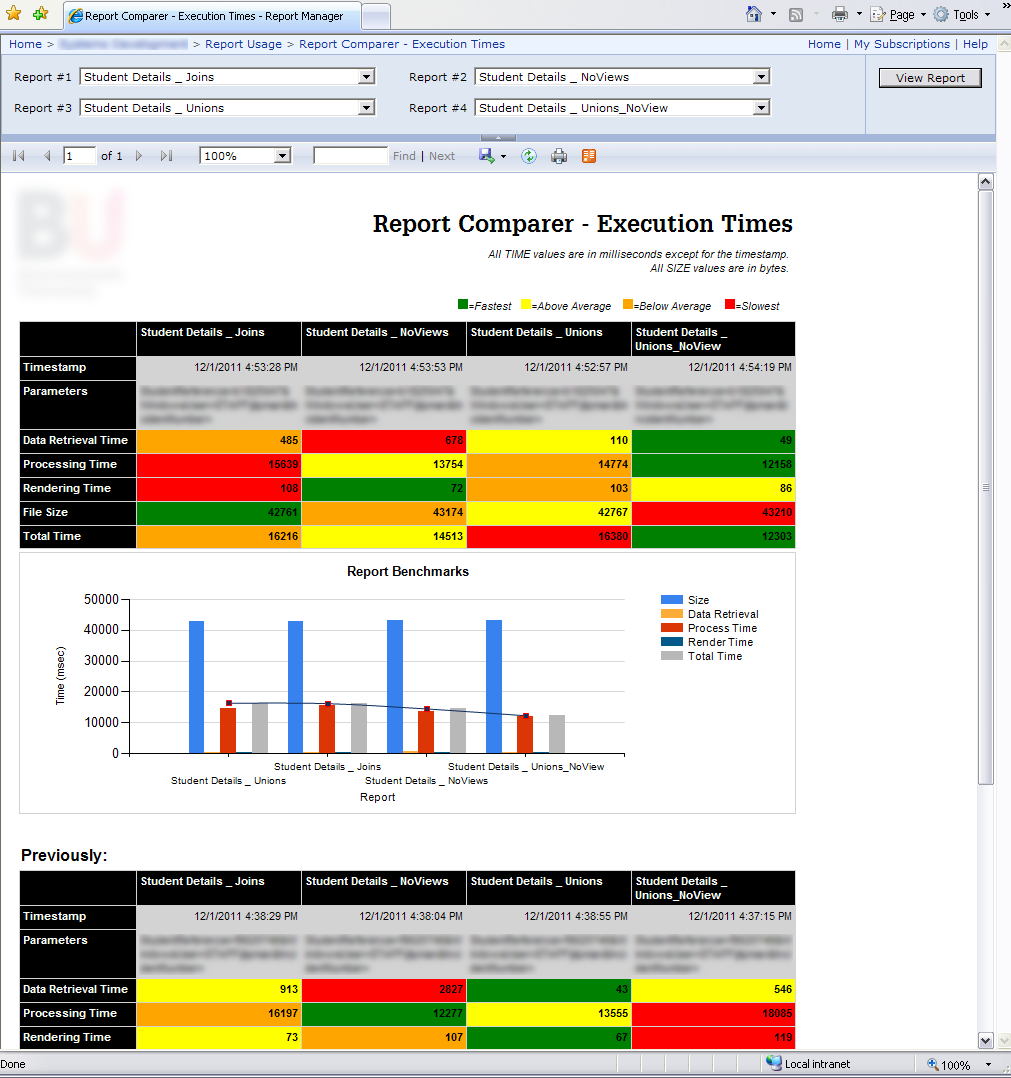SSRS Retrieving Oracle Stored Procedure Success or ErrorLevel
- Category: SQL Server Reporting Services
- Hits: 45865
We have a report in SQL Server Reporting Services 2008 R2 (SSRS) reading from an Oracle 10g database which works great and lists all the details on a specific student. An additional request is that there appears a link that will run a stored procedure which
- Updates a timestamp in an existing table
- Inserts a row into an audit table
How?
SSRS AlphaNumeric Parameter Validation
- Category: SQL Server Reporting Services
- Hits: 25900
If you ever want to check the parameters submitted with a report for alpha numeric characters (so it doesn't contain symbols, punctuations, etc) then you should do this at the database level, and then get the report to complete the check:
The Plan
- User enters value in parameters and clicks on "View Report"
- Report passes parameter to dataset which gets formatted by the database
- Report retrieves (select) formatted parameter as a field value to use
- Report loads with changes based on returned value.
The Gist
- Add database level parameter check
- Add IIF in SSRS to confirm
How to Display Report Execution Time in SSRS (milliseconds)
- Category: SQL Server Reporting Services
- Hits: 68722
So there are other articles out there but I was looking to display in milliseconds the execution time it took for a particular report (which searches for results matching the submitted parameter) to run.
Lifted from Dattatray Sindol's blog
Other sites have this solution as well so who copied off who is not my concern as this is not the solution to our problem. This is the solution that I initially used but my end-users were asking why is it always 0 seconds. This was because we were using the following MDX statement which had seconds as its smallest denominator:
="Execution Time: " + CStr(System.DateTime.Now.Subtract(Globals!ExecutionTime).Hours) + " hour(s)" + " , " + CStr(System.DateTime.Now.Subtract(Globals!ExecutionTime).Minutes) + " minute(s)" + ", " + CStr(System.DateTime.Now.Subtract(Globals!ExecutionTime).Seconds) + " second(s)" // yields // 0 hour(s), 1 minute(s), 2 second(s)This isn't what I want... It wasn't accurate enough and always saying 0 seconds was just confusing the end-user...
Performance Report - Background colors based on dataset values
- Category: SQL Server Reporting Services
- Hits: 37153
I've recently written a report for SQL Server Reporting Services 2008 R2 (SSRS) which will compare up to 4 reports and will compare the time taken for each one. The breakdown or what I was able to measure with the default installation are the times taken for "data retrieval", "processing", "rendering", and then the totals of these.
I haven't Googled this at the time of print so there may be a million better solutions out there, this is just how I did it. This may look like a horrible report which would fail an accessibility test but visually it says straight away which is the better report; and when comparing to the previous runs (using a second dataset) you can tell where changes were made and how this affected the reports' performance.
What?
What I'm trying to do is display a set of results (comparing various reports) in a table and then to color the backgrounds based on whether they are the fastest or slowest in the set.
Something like:

SSRS Dropdown parameter cannot be blank!
- Category: SQL Server Reporting Services
- Hits: 52509
I have created an SSRS report which can compare 4 reports side by side and brings up their latest execution times to the nearest millisecond. The report has 4 parameters. Each parameter is a dropdown populated by a list of all available reports.
Why?
I want the report to be run with the 3rd and 4th parameter as OPTIONAL. When I leave the 3rd and 4th parameter untouched (="<Select a value>"), the report complains saying "Report #3 parameter cannot be blank!". Before you ask, I have ticked both "Allow Blank" and "Allow NULL".
How?
This is the tough part. I was reading up on the MSDN page for the closest solution but it still didn't work for me. But the idea of inserting a NULL entry to select sounded good.
Aim / Objective
The plan will be to replace the default "<Select a Value>" with a custom null entry and the end-user will be none the wiser.
Returning Oracle Stored Procedure Resultset in SSRS
- Category: SQL Server Reporting Services
- Hits: 134748
So I've spent a fun time googling and binging but still haven't found a simple and complete example of getting a resultset from an Oracle stored procedure and displaying this in SQL Server Reporting Services (SSRS). Well "non-productive" more than "fun" as most of the examples on the net are either half-complete or partially documented. So here goes...
- Using Business Intelligence Development Studio v2008 (BIDS)
- SQL Server Reporting Services v2008 R2 (SSRS)
- Oracle SQL Developer v3 (you can use any equivalent, eg. SQL*Plus)
Why?
I think this is one of those very rare occasions that Microsoft people can say "it's so much easier using a Microsoft product to work with another Microsoft product" (ie "Seamless integration"). Yes, I'm trying to get an SSRS report to display the results from an Oracle stored procedure. I have a previous article describing a basic stored procedure in Oracle, this article aims to outline how to apply this to an SSRS 2008 R2 report.
Problem creating SSRS report subscriptions
- Category: SQL Server Reporting Services
- Hits: 19541
A quick article on if you are trying to create a new subscription to a SQL Server Reporting Server (SSRS) report and you are getting a warning message similar to the following:
Message from webpage Subscriptions cannot be created because the credentials used to run the report are not stored, or if a linked report, the link is no longer valid.
Why?
The problem happens because of the data source used in the report. For static data source connections, this is straightforward but in our case, we have a report which points to different servers based on a report parameter.
How?
SSRS Subscriptions cannot be created
- Category: SQL Server Reporting Services
- Hits: 26070
- Microsoft Business Intelligence Development Studio 2008 (BIDS)
- Microsoft SQL Server 2008 R2
This article describes solutions to the error:
Subscriptions cannot be created because the credentials used to run the report are not stored, or if a linked report, the link is no longer valid.
How?
Page 8 of 12
Credit where Credit is Due:
Feel free to copy, redistribute and share this information. All that we ask is that you attribute credit and possibly even a link back to this website as it really helps in our search engine rankings.
Disclaimer: Please note that the information provided on this website is intended for informational purposes only and does not represent a warranty. The opinions expressed are those of the author only. We recommend testing any solutions in a development environment before implementing them in production. The articles are based on our good faith efforts and were current at the time of writing, reflecting our practical experience in a commercial setting.
Thank you for visiting and, as always, we hope this website was of some use to you!
Kind Regards,
Joel Lipman
www.joellipman.com
Latest Articles
Accreditation



Donate & Support
If you like my content, and would like to support this sharing site, feel free to donate using a method below:

 bc1qf6elrdxc968h0k673l2djc9wrpazhqtxw8qqp4
bc1qf6elrdxc968h0k673l2djc9wrpazhqtxw8qqp4
 0xb038962F3809b425D661EF5D22294Cf45E02FebF
0xb038962F3809b425D661EF5D22294Cf45E02FebF
Paypal:

Bitcoin:
 bc1qf6elrdxc968h0k673l2djc9wrpazhqtxw8qqp4
bc1qf6elrdxc968h0k673l2djc9wrpazhqtxw8qqp4
Ethereum:
 0xb038962F3809b425D661EF5D22294Cf45E02FebF
0xb038962F3809b425D661EF5D22294Cf45E02FebF






